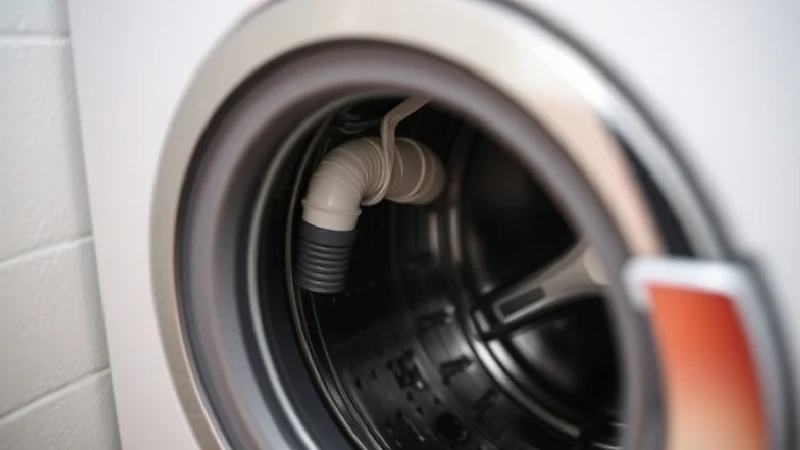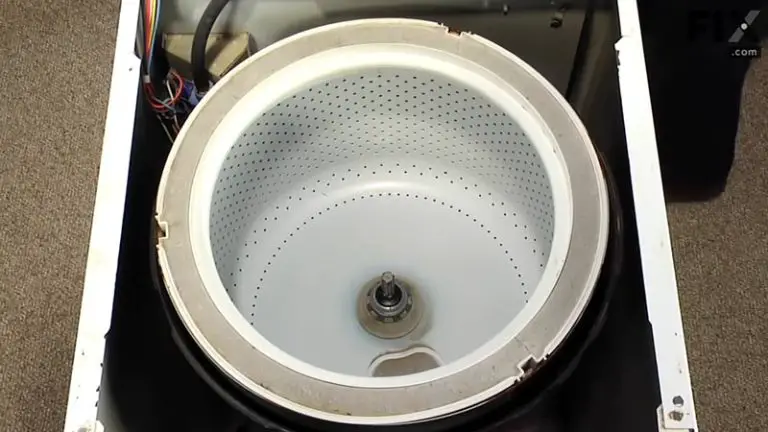Washing Machine Drain Hose Stuck in Wall: What to Do?
A common problem homeowners face is a washing machine drain hose that becomes stuck in the wall. This issue can arise due to various reasons such as improper installation, debris build-up, or wear and tear.
Addressing this problem promptly is crucial to prevent potential water damage, maintain the efficiency of your washing machine, and avoid costly repairs.
This article provides a comprehensive guide on how to safely and effectively remove a stuck washing machine drain hose from the wall, including preventive measures and useful tips.
You'll Learn About
Understanding the Problem

Causes of a Stuck Drain Hose
Several factors can cause a washing machine drain hose to become stuck in the wall:
- Improper Installation: Incorrect installation can lead to the hose being wedged too tightly or at an awkward angle.
- Debris Build-Up: Over time, lint, detergent residue, and other debris can accumulate, causing the hose to stick.
- Wear and Tear: Older hoses may degrade or expand, making them difficult to remove.
- Clogs and Blockages: Objects or blockages within the hose can also contribute to it being stuck.
Potential Risks
Leaving a stuck drain hose unattended can result in:
- Water Damage: Leaks or bursts can cause significant damage to walls, floors, and surrounding areas.
- Reduced Efficiency: A partially blocked or misaligned hose can impede the washing machine’s drainage efficiency.
- Health Hazards: Stagnant water and mold growth can pose health risks.
Steps to Remove a Stuck Washing Machine Drain Hose
Step 1: Prepare and Assess
Tools and Materials Needed
- Adjustable wrench or pliers
- Utility knife
- Bucket or towels
- Flashlight
- Flexible cleaning brush or snake
- Pipe lubricant or soap
- Protective gloves
Initial Assessment
- Turn Off Power and Water Supply: Unplug the washing machine and turn off the water supply to prevent any accidental flooding or electrical hazards.
- Clear the Area: Remove any obstacles around the washing machine to provide ample working space.
Step 2: Inspect and Loosen the Hose
- Locate the Hose Connection: Use a flashlight to clearly see where the hose is connected to the wall drain pipe.
- Try Gentle Pulling: Wearing protective gloves, gently pull on the hose to see if it moves. Avoid using excessive force to prevent damage.
- Apply Lubricant: Apply a small amount of pipe lubricant or soap around the hose connection to help loosen any debris or residue.
Step 3: Use Tools for Assistance
- Wrench or Pliers: If the hose is still stuck, use an adjustable wrench or pliers to carefully grip and twist the hose, which may help break it free from any debris or blockages.
- Cut the Hose (if necessary): If the hose is damaged or extremely stuck, use a utility knife to carefully cut the hose a few inches from the wall connection. This provides better leverage and access to remove the remaining portion.
Step 4: Clear Blockages and Remove Debris
- Insert a Cleaning Brush: Use a flexible cleaning brush or snake to insert into the hose and clear out any debris or blockages that might be causing it to stick.
- Flush with Water: Pour water through the hose to help dislodge any remaining debris. Use a bucket or towels to catch any water that comes out.
Step 5: Remove the Hose
- Final Pull: With the hose loosened and cleared of debris, gently pull it out of the wall connection. Use a twisting motion to help ease it out if it’s still resistant.
- Check for Damage: Once removed, inspect the hose for any signs of wear, cracks, or blockages. Replace the hose if it’s damaged.
Preventive Measures
Proper Installation
- Correct Length and Fit: Ensure the drain hose is the appropriate length and properly fitted to avoid kinks or bends.
- Secure Connections: Use hose clamps to secure the hose to the washing machine and wall drain pipe, preventing it from becoming loose or detached.
Regular Maintenance
- Clean the Hose Periodically: Regularly clean the drain hose to prevent debris build-up and blockages.
- Check for Wear and Tear: Periodically inspect the hose for signs of wear, cracks, or damage and replace it as needed.
- Use a Mesh Lint Trap: Install a mesh lint trap at the end of the drain hose to catch lint and debris before they enter the drain system.
Proper Usage
- Avoid Overloading the Washing Machine: Overloading can cause excess lint and debris, contributing to hose blockages.
- Use the Right Detergent: Using too much or the wrong type of detergent can cause residue build-up inside the hose.
How to Get a Washer Drain Tube Out
Identify the Type of Clamp on the Drain Tube
Washer drain tubes are typically secured with clamps to ensure stability. The most common type is a standard spring hose clamp. These clamps can be easily loosened with the correct tools and technique.
Examine the clamp to identify the projecting parts that hold it. The projecting parts are where the clamp can be manipulated to loosen. Knowing the type of clamp will help you prepare for the removal process.
Most washer drain tubes use these spring hose clamps to secure the connection. Once you are familiar with the type of clamp, gather the necessary tools for removal. Pliers are essential for this step and will provide better control.
Loosen the Clamp with Pliers
Using pliers is an effective way to loosen the spring hose clamp. Position the pliers on the projecting parts of the clamp. Apply pressure by squeezing the pliers together to release the tension from the clamp.
This action will allow the clamp to move freely down the hose. Ensure that you have a firm grip on the pliers to prevent slipping. Once the clamp is loosened, slide it down the hose, past the area it clamps onto.
Take care during this step to avoid damaging the drain tube or hose. The clamp must be fully loosened before attempting to remove the washer drain tube. This method makes it much easier to pull the hose free without resistance.
Pull the Hose Off the Connection Point
After loosening and sliding the clamp, it’s time to remove the hose. Grasp the hose firmly and pull it off the connection point. Twisting the hose back and forth slightly can help if it feels stuck.
The goal is to pull the hose free without damaging it. Use steady, even pressure to ensure it slides off easily. If you find the hose particularly resistant, double-check that the clamp has been fully loosened.
The hose may require some wiggling to break the seal created by suction or debris. Be patient during this step, and avoid pulling too hard, as this could cause damage. A steady approach will allow the tube to come out cleanly and safely.
Check for Obstructions or Debris in the Drain Connection
Once the hose is free, inspect both the hose and the connection point. Look for any obstructions or debris that may have caused the tube to stick. Debris or buildup can create tension and make removal more difficult.
Clean the connection point and drain hose if necessary to ensure they are free of blockages. This will also help prevent similar issues from happening in the future. Keeping the drain connection clear will maintain smooth water flow and proper drainage.
Regular maintenance can prevent clogs or sticking issues in the future. If needed, use a damp cloth or a small brush to clean any debris from the connection point. A clean connection ensures optimal performance for your washer.
Reattach the Drain Tube with the Clamp if Necessary
Once the drain tube is removed, reattach it securely if reinstalling is required. Slide the spring clamp back into place around the hose connection. Use pliers to squeeze the clamp and slide it into its proper position.
Ensure the hose is positioned properly before securing the clamp. The hose should fit snugly against the drain connection point without gaps. After securing the clamp, test the connection to confirm there are no leaks.
If you are replacing or reinstalling a new washer drain tube, ensure it is compatible with your machine. The correct fit will ensure efficient drainage and prevent potential issues in the future. Proper reinstallation is important for maintaining the appliance’s performance.
Use Proper Tools for a Safe and Efficient Process
Always use pliers or other appropriate tools when attempting to remove a washer drain tube. The right tools make the process safer and reduce the risk of damage. Avoid using makeshift tools, as these can slip and cause injury.
Ensure your work area is clear, and the washer is turned off. This will prevent accidental water flow or further complications during the process. Having the proper tools and a clean, well-lit workspace makes the removal much easier.
Take your time with the process and follow each step carefully. Pliers and a steady hand can solve most washer drain tube issues. Avoid rushing, as rushing can lead to unnecessary strain on the drain tube or connections.
Prevent Future Washer Drain Tube Issues with Regular Maintenance
Washer drain tubes can become stuck or difficult to remove if neglected. To avoid this issue, clean and maintain the drain area on a regular basis. Check the hoses and connection points for signs of wear, rust, or debris.
Regular maintenance will keep your washer drain system working efficiently. Clear any blockages or debris as soon as they are noticed to prevent buildup. Regular care will ensure that the drain tube is easier to work with in the future.
Washer drain tubes typically last a long time with proper maintenance. Keeping the system in good shape allows your appliance to operate at its peak performance. Preventative maintenance is a simple yet effective way to avoid costly repairs and issues. Some washers drain into sink.
Comparison of Tools and Techniques for Removing a Stuck Drain Hose
| Tool/Technique | Description | Pros | Cons | Best Used For |
|---|---|---|---|---|
| Manual Pulling | Gently pulling the hose to free it from the wall connection | Simple, no additional tools needed | Risk of damage if force is applied | Light to moderate sticking |
| Pipe Lubricant/Soap | Applying lubricant around the hose connection to ease removal | Reduces friction, easy to apply | May be messy, not always effective | Hose stuck due to debris/residue |
| Wrench or Pliers | Using tools to grip and twist the hose | Provides additional leverage | Risk of damaging hose | Moderately to severely stuck hoses |
| Cutting the Hose | Cutting the hose for better access and leverage | Effective for severely stuck hoses | Hose will need replacement | Severely stuck or damaged hoses |
| Cleaning Brush/Snake | Inserting a flexible brush or snake to clear blockages inside the hose | Clears debris effectively | Requires additional tools | Blockages causing hose to stick |
By understanding the causes and solutions for a stuck washing machine drain hose, homeowners can tackle this common issue with confidence, ensuring their appliance continues to function efficiently and effectively.
Conclusion
A stuck washing machine drain hose can be a significant inconvenience, but with the right tools and techniques, it can be resolved effectively. By following the steps outlined in this guide, you can safely remove a stuck hose, prevent water damage, and maintain the efficiency of your washing machine.
Additionally, adopting preventive measures will help avoid future issues and prolong the life of your appliance. Sometimes also sink gurgles when washing machine drains.

